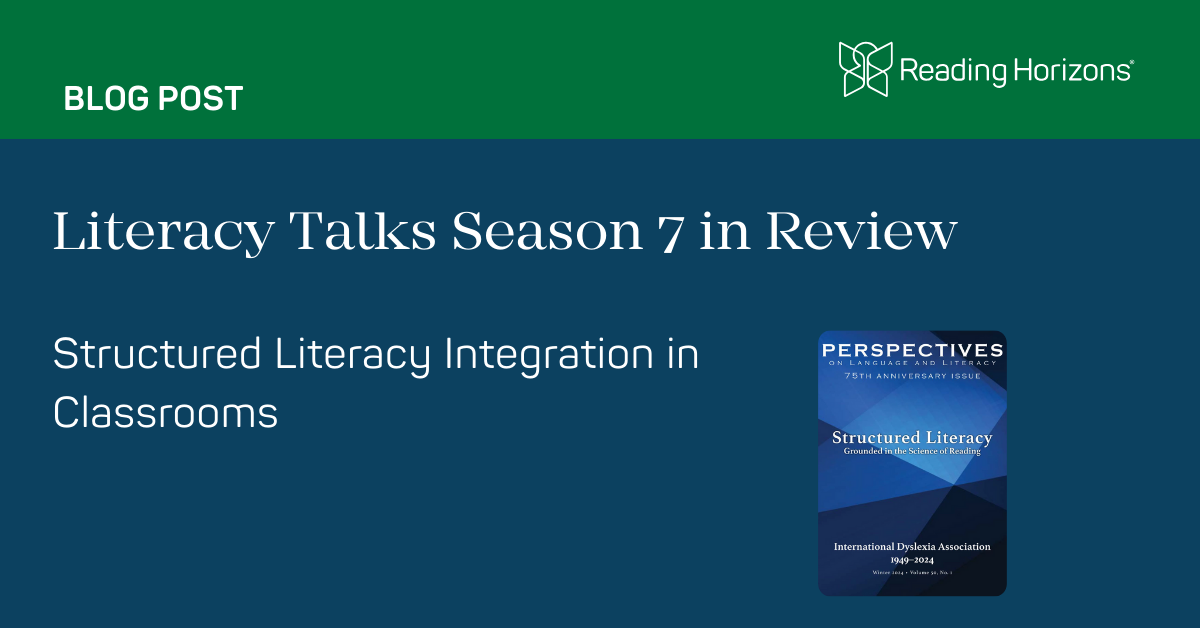The Season 7 finale of Literacy Talks marks a milestone in exploring how the Science of Reading continues to reshape how educators understand, deliver, and evolve literacy instruction. Anchored in the 75th Anniversary Issue of Perspectives, by the International Dyslexia Association (IDA), this season focused entirely on the concept of Structured Literacy—its research base, evolution, integration, and classroom application.
As hosts Stacy Hurst, Donell Pons, and Lindsay Kemeny reflected on the season’s standout moments, expert interviews, and insights from field practitioners, one theme stood out above all: integration—not just of reading components, but of systems, roles, and voices across the educational landscape.
A Season Framed by the Science of Reading
This was the first themed season of Literacy Talks, and it provided a rare opportunity to deeply examine one topic from multiple lenses. The structure was anchored in IDA’s info map—a comprehensive, interactive guide to the principles and practices that define Structured Literacy.
The hosts agreed that the theme helped them revisit and sharpen their understanding of the field.
As science advanced, IDA evolved. As we evolved, our vision sharpened.
The result was not just a celebration of how far Structured Literacy has come, but an invitation to reflect on what educators still need to know—and how to take meaningful next steps.
Structured Literacy: More Than Phonics
One of the most critical takeaways from the season was a resounding call to push beyond a narrow view of Structured Literacy.
Structured Literacy is a lot more than phonics.
As the hosts and their guests emphasized, Structured Literacy encompasses a web of interconnected components: phonology, orthography, syntax, semantics, and comprehension—all taught explicitly, systematically, and cumulatively.
The recurring theme of integration was echoed across episodes, showing that no single element of literacy can be taught in isolation. Vocabulary, sentence structure, background knowledge, text structure, and critical thinking must all work together to support readers—especially those who struggle.
This understanding was powerfully reinforced through insights shared by researchers such as Kate Cain, whose work on comprehension and composition helped unpack how deeply layered reading and writing processes truly are.
The recurring theme of integration was echoed across episodes, showing that no single element of literacy can be taught in isolation. Vocabulary, sentence structure, background knowledge, text structure, and critical thinking must all work together to support readers—especially those who struggle.
Spotlight on Educator Knowledge and Collaboration
Another central message of the season was the vital role of teacher knowledge and the need for strong collaboration between educators and researchers.
Readers still struggle when we lead with discovery-based models. If they could discover it, they already would have.
The hosts emphasized that explicit and systematic instruction remains the most reliable approach for ensuring all students learn to read—especially those who don’t naturally pick up on language patterns.
From a practical standpoint, this means empowering teachers through ongoing professional learning and ensuring that they are at the center of curriculum decisions. Guests such as Margaret Goldberg and Barbara Wilson highlighted how effective instruction is not only program-based but teacher-driven.
Structured Literacy may include a program… but supported, trained teachers drive the integration of instruction.
The Value of a Shared Framework
The IDA’s info map was praised by the hosts as a critical tool—not only for its clarity and comprehensiveness, but also for how it enables shared language and collaboration across classrooms, schools, and systems.
In a profession often fragmented by varied curricula and philosophical divides, Structured Literacy offers a common foundation. This is particularly important for ensuring continuity between classroom instruction and interventions, as well as communication among teachers, administrators, specialists, and families. “I wouldn’t just send my students to intervention without knowing what they’re doing. There needs to be communication. A framework like this gives us that,” said Stacy Hurst.
Lessons from the Experts
Throughout the season, Literacy Talks welcomed powerhouse voices in literacy education:
- Margaret Goldberg, known for her transition from balanced to structured literacy, brought a pragmatic, real-classroom view of what works.
- David Hurford highlighted legislative and systemic efforts to support evidence-based practices.
- Louise Spear-Swerling helped clarify distinctions between Structured Literacy and older models, while offering tools like the Reader Profile for actionable assessment.
- Elsa Cárdenas-Hagan provided insight into multilingual learners and the need for culturally responsive, language-rich instruction.
Each guest underscored the importance of honoring teacher experience while grounding practice in research. And just as crucially, they demonstrated that Structured Literacy isn’t a static set of rules—it’s a dynamic, evolving framework.
Integration at Every Level: Systemic Thinking and Support
A particularly powerful thread emerged around the need for systemic thinking. Structured Literacy must extend beyond individual classrooms into district leadership, policy, assessment, and professional development.
The hosts challenged listeners to think beyond day-to-day teaching and consider how multi-tiered systems of support (MTSS), school culture, and leadership practices can enable—or hinder—the success of literacy instruction.
This perspective was influenced by discussions around Tim Odegard’s work, which emphasized how much more is required to support students with dyslexia, as well as how critical it is to align systems with instruction and intervention.
Final Reflections: What’s Next in Structured Literacy?
As Season 7 wrapped, the hosts left listeners with encouragement and direction:
- Start small, stay consistent. Don’t get overwhelmed—engage with one resource or concept at a time.
- Use the info map. It’s a powerful, accessible tool to guide teaching, professional learning, and curriculum choices.
- Foster collaboration. Build bridges between researchers and teachers—and advocate for teacher voices to be part of every decision.
- Think like a scientist. Stay curious, keep learning, and allow evidence—not habits—to guide instruction.
“Science doesn’t take sides. It illuminates a path.” — Quoted from the article by Reed Lyon and Margaret Goldberg
Conclusion: The Journey Ahead
Season 7 of Literacy Talks was a deep dive into not just what Structured Literacy is—but what it can be when embraced across roles, systems, and mindsets. As the science evolves, so must our practice.
For educators, the takeaway is clear: we have the framework, we have the tools, and we have a growing community. The next step is integration—not only in instruction, but in how we think, collaborate, and lead.

